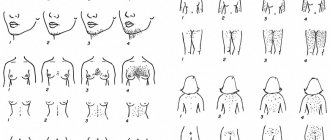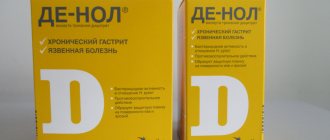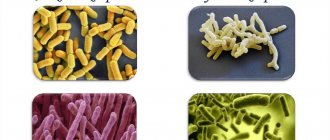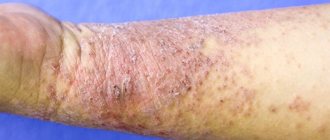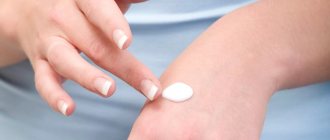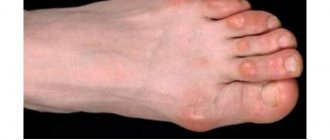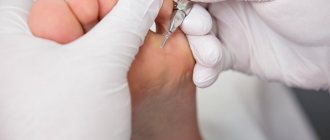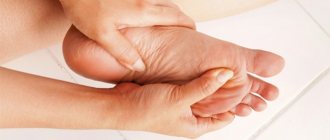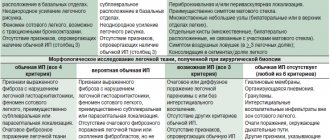How can you get scabies?
The female Sarcoptes scabiei is about 0.3 mm in size and lives for only 1 month, but this is quite enough to lay eggs. Thousands of new females develop from the hatched larvae.
Features of the disease!
Human skin is parasitized by females that have specific “hooks” with which insects make passages in the skin. This process is important for reproduction. In the passages made, the eggs develop into larvae.
A tick passes from a sick person to a healthy person through close contact - these are unsanitary conditions, promiscuous sex, living in a room with a large crowd of infected people. Sometimes the tick is transmitted through household and hygiene items - towels, washcloths, so the disease can be contracted in public baths or swimming pools.
Children and adults!
Children become infected with scabies more often, and the mite is transmitted precisely in children's groups, because children do not follow hygiene rules and exchange personal belongings and toys.
Contact your doctor or nurse if:
- 4 weeks after treatment you still have itching or rash;
- 1 week after treatment you develop a new rash, blisters or peeling skin;
- after treatment, the rash turns into a scab;
- you have one of the following signs of infection: the rash is leaking fluid;
- the site of the rash becomes painful;
- the skin feels warm to the touch;
- redness begins around the rash;
- developed a temperature of 100.4°F (38°C) or higher.
to come back to the beginning
Incubation period
As such, there is no incubation period for the disease. because a person is considered sick at the moment of first contact with a tick. Although the symptoms of the disease themselves appear after different times, which depend on the stage of development of the parasite.
If an adult female gets on the skin, then she can lay eggs in 2-5 hours, since she gnaws passages in the skin and lays 3-4 eggs a day from the first minute.
If larvae get on the skin, they turn into sexually mature individuals in 12-14 days.
How to get rid of scabies mites in the house
Scabies mites die when exposed to high temperatures. To kill scabies mites on bedding, clothing and towels:
- Wash items in a washing machine with hot water and dry them in the dryer on a hot cycle for at least 20 minutes;
- If items cannot be washed, then pack them in a sealed plastic bag. Keep the package closed for 5-7 days.
If the person living with you has scabies, then wash all the things that anyone in the house has worn in the last 4-5 days. This will help you and the people living with you not to get scabies from dirty clothes.
People with crustose scabies are highly contagious. It is very important to thoroughly vacuum the furniture and carpets in the room where the infected person was. At the same time, there is no need to disinfect residential premises by fumigation.
to come back to the beginning
Signs of infection
The disease can be suspected by the manifestation of skin itching, which is mild during the day, but intensifies in the evening and at night. Even a small number of parasitic insects cause itchy skin as the body reacts to mite excrement. If the parasite population grows without treatment, the itching becomes very unbearable. But its intensity still depends on the susceptibility of the individual organism.
Another important feature of the disease is the localization of the parasite. Ticks parasitize on certain parts of the body, so before starting treatment it is important to identify in which places a person is bothered by itching.
In adults, areas of the body with thin skin are more often affected:
- elbow and wrist bends;
- folds under the mammary glands;
- space between fingers;
- genitals;
- body on the sides.
In children, the parasite is localized:
- along the inner edges of the feet;
- on the buttocks, soles of the feet;
- face and head;
- palms.
In addition to itching, peeling and irritation are noticeable on the skin. To make a final diagnosis, it is necessary to identify the scabies tracts.
Important!
Scabies cannot be confused with another rash, since they have two openings - an entrance and an exit, which look like paired pimples. The stroke length is several millimeters; it is almost impossible to detect them with the naked eye.
Itchy skin causes great trouble, but a person does not immediately consult a doctor. Often the signs of the disease can be confused with allergic reactions, and the person tries to treat himself. At an early stage of the disease, treatment with antihistamines is still effective - the itching decreases, and the person believes that he has recovered. But antihistamines only relieve the symptoms of a reaction to parasite feces, while the mite continues to live and develop on the body, and the itching returns and intensifies over time. Therefore, it is important to consult a specialist at the first suspicion of scabies.
Modern approaches to the diagnosis and treatment of scabies
Scabies is a contagious parasitic skin disease caused by the scabies mite Sarcoptes scabiei, accompanied by itching, worse in the evening and at night, and papular-vesicular rashes.
Currently, scabies remains one of the most common parasitic dermatoses in our country.
An increase in the number of patients with scabies usually accompanies wars, natural disasters, and social upheavals, which is caused by population migration, economic recession, and deterioration of social and living conditions.
As mentioned above, the causative agent of scabies is the scabies mite - Sarcoptes scabiei. This species belongs to the family Sarcoptidae, group Acaridiae, suborder Sarcoptiphormes, order Acariphormes. Members of the genus Sarcoptes are currently known as parasites of more than 40 species of animal hosts belonging to 17 families of 7 orders of mammals.
The morphological appearance of scabies mites of the Sarcoptidae family is extremely unique and is due to profound adaptations to intradermal parasitism. The structure of scabies, like most mites, is characterized by strict constancy of the microstructures of the exoskeleton, which is associated with their microscopic size.
The female scabies mite resembles a turtle in appearance. Its size is 0.25–0.35 mm. Adaptations for intradermal parasitism are represented by multiple setae, triangular outgrowths of the cuticle on the dorsal surface, spines on all tarsi that serve as stops when gnawing, gnawing-type chelicerae, long elastic bristles on the tarsi of the hind pairs of legs to maintain the direction of the gait only forward. Adaptations for ectoparasitism are sticky pneumatic suckers on the front legs, waxy bristles on the body and limbs, which create an extensive mechanoreceptive sphere around the tick and allow it to navigate by touch without eyes. The speed of movement of the female during the course is 0.5–2.5 mm/day, and on the surface of the skin 2–3 cm/min. Scabies mites are characterized by sexual dimorphism. The main function of males is fertilization. They are much smaller in size - 0.15–0.2 mm, have dense bristles on the body for protection from mechanical stress and suckers also on the fourth pair of legs for attachment to the female during mating. The ratio of females to males in scabies mites is 2:1.
The life cycle of the scabies mite is clearly divided into two parts: short-term cutaneous and long-term intradermal. Intradermal is represented by two topically separated periods: reproductive and metamorphic. Reproduction is carried out by the female in the itch she gnaws, where she lays eggs. The hatching larvae emerge from the passages onto the surface of the skin through holes made by the female above the site of each clutch, settle on it and penetrate into the hair follicles and under the scales of the epidermis. Here their metamorphosis (molting) occurs: through the proto- and teleonymph stage, new individuals (females and males) are formed. Females and males of the new generation come to the surface of the skin, where they mate. Daughter females migrate to the hands, wrists, feet, penetrate the skin and immediately begin to make passages and lay eggs. In rare cases, the introduction of females is possible in other areas of the skin (buttocks, axillary areas, abdomen, etc.) due to mechanical pressure. Clinically, this corresponds to scabious lymphoplasia of the skin. Only females and larvae are infective stages and participate in infection. At room temperature and relative humidity, at least 60% of females retain mobility for 1–6 days. Even at 100% humidity, females survive on average up to 3 days, larvae - up to 2 days.
Scabies mites are characterized by a strict daily rhythm of activity. During the day, the female is at rest. In the evening and in the first half of the night, she gnaws one or two egg knees at an angle to the main direction of the stroke, in each of which she lays an egg. Before laying eggs, she deepens the bottom of the passage, and makes an exit hole in the roof for the larvae. During the second half of the night, the female gnaws the passage in a straight line, feeding intensively; during the day, she stops and freezes. The daily program is carried out by all females synchronously. As a result, the itch on the patient's skin has a convoluted shape and consists of segments of the course, called the daily element of the course. The posterior part of the tract gradually peels off, and during a clinical examination of the patient, it simultaneously consists of 4–7 daily elements and has a constant length of 5–7 mm. During her life, the female travels 3–6 cm in the epidermis; the revealed daily rhythm of activity is of great practical importance. It explains the intensification of itching in the evening, the predominance of the direct route of infection through contact in bed in the evening and at night, and the effectiveness of prescribing anti-scabies at night.
Clinical picture
The clinical picture of scabies is determined by the characteristics of the pathogen and the reaction of the host body to its introduction.
The incubation period for scabies varies in length and depends on whether the skin is an adult female or a larva. In the first case it is extremely short, and in the second it is 2 weeks. Itching, as the main symptom of scabies, appears in a period that ranges from 14 days to 6 weeks during primary infection and can be extremely short, limited to a few days during reinfection. It has also been shown that reinfection, however, may be more difficult in already sensitized individuals, and the number of detectable scabies mites in such patients is often minimal [7, 9].
The typical form of scabies is characterized by the presence of itchy skin, which is most pronounced in the evening and during sleep. However, the itching can also be constant. It can be localized to individual areas of the skin or spread throughout the body, with the exception of the facial skin and scalp. An extremely important sign is the presence of itching among family or team members.
During the examination, specific rashes are revealed. The main clinical symptoms of scabies are scabies, polymorphic rashes outside the tracts, characteristic sites of rashes, as well as symptoms named after the authors Ardi (presence of pustules and purulent crusts on the elbows and in their circumference), Gorchakov (presence of bloody crusts there), Michaelis (presence of bloody crusts and impetiginous rashes in the intergluteal fold with transition to the sacrum), Sezari (detection of scabies in the form of a slight elevation on palpation).
Typical localization sites for rashes are predominantly the flexor surface of the joints (wrist and elbow), as well as the anterolateral surface of the abdomen, lower back, buttocks, and genital area, while they are absent on the upper half of the back. Scabies and rashes are well expressed in the interdigital and axillary folds, on the areola of the breast of women, in the navel area. The rashes are represented by paired papules and vesicles, scabies, eczematous pseudovesicles (pearly vesicles) on the skin of the lateral surfaces of the fingers and palms; scabious ulcers, with crusts on the surface; as well as scabious nodules.
It seems to us advisable to classify and present atypical forms of scabies
- scabies without skin lesions;
- urticarial scabies;
- scabies during corticosteroid therapy;
- nodular (with postscabiosis nodules) scabies;
- eczematized scabies;
- scabies complicated by pyoderma;
- Norwegian scabies;
- infant and childhood scabies.
The first two forms are caused primarily by allergic reactions.
Scabies without skin lesions can represent the beginning forms of the disease in people who observe standards of body hygiene, but more often it manifests itself as an allergic reaction to mite antigens during the period of the disease or after its treatment. This form of the disease is more often detected during an active examination of persons who have been in contact with a patient with scabies.
Urticarial scabies is represented by small blisters caused by sensitization to both mites and their metabolic products. They occur more often on the front of the torso, thighs, buttocks and forearms.
Scabies with local corticosteroid therapy, also called latent scabies, as a result of suppression of the immune reactions of the skin, leads to the loss of specific symptoms of scabies. The disease acquires papulosquamous, papulovesicular, and sometimes even hyperkeratotic rashes.
Nodular scabies (scabious lymphoplasia) is characterized by the appearance of itchy nodules that are red, pink or brown. Scabies can be found on the surface of new nodules. Typical localization: penis, scrotum, axillary and intergluteal folds, areola. The nodules are usually few in number. Sometimes they are the only diagnostic sign of scabies [2, 4].
Eczematized scabies usually occurs in people with an allergic predisposition. Foci of lichenification may appear at the sites of scratching. However, eczematous lesions usually come to the fore and the diagnosis of scabies may not always be suspected. Rashes appear on the hands, armpits, legs, and hands. In advanced cases, the rash can become disseminated, leading to the development of erythroderma.
In persons with reduced body resistance, eczematized lesions at the sites of scratching may be accompanied by a secondary bacterial infection in the form of impetigo or ecthyma; staphylococcal folliculitis, boils and abscesses may occur.
Norwegian scabies (crustic, crusted) in the initial stages is presented as ordinary scabies or disguised as atopic dermatitis, psoriasis, seborrheic dermatitis. Characterized by keratinization, the formation of scales or thick crusts. In case of severe immunodeficiency, the process can be generalized; in case of neurological diseases, it can manifest itself in a limited area of sensory impairment.
Infant and childhood scabies are characterized by rashes resembling urticaria or infant pruritus in the form of a large number of scratched and crusty blisters with a predominant localization in the perineum on the scrotum, in the axillary folds. Characteristic scabies can be found on the soles.
Diagnostics
Diagnosis of scabies, in addition to clinical data, is based on microscopic confirmation of the diagnosis. However, this procedure requires considerable skill, an experienced microbiologist, and is not feasible in some clinical forms. The minimal clinical manifestations of scabies also make it difficult to obtain sufficient biological material for research. The technique has advantages in specialized institutions. There are several methods for laboratory diagnosis of scabies: removing the mite with a needle, the method of thin sections, scrapings, alkaline skin preparation.
Treatment
For the treatment of scabies, various preparations of sulfur, benzyl benzoate, Peruvian balsam, etc. were previously proposed. In recent years, new drugs have begun to be used, such as Spregal, crotamiton, lindane, malathion, permethrin, Prioderm, Tetmosol, thiobendazole, prescribed in the form of ointments, creams, solutions , shampoos, emulsions and aerosols. The main requirements for anti-scabies are the speed and reliability of the therapeutic effect, the absence of irritating effects on the skin and contraindications for use, ease of preparation and use, stability during long-term storage, availability for mass use, hygiene and low cost [8, 9] . In addition, various forms of scabies, such as postscabiosis, eczematized or urticarial, require the addition of pathogenetic therapy.
General principles: rubbing anti-scab preparations into the skin, especially carefully into the mite’s favorite localization areas. After each forced hand washing, it is necessary to re-treat them with an anti-scabies agent. In the presence of complications (primarily pustular skin lesions), lubrication rather than rubbing is performed. Before starting treatment, it is advisable to take a hot shower or bath, using a washcloth and soap to mechanically remove mites from the surface of the skin, as well as to loosen the surface layer of the epidermis, which simplifies the penetration of antiscabiotic drugs. In the presence of secondary pyoderma, water procedures are contraindicated. Regardless of the method of therapy, the entire skin is treated with an anti-scabies drug. Avoid contact of the drug with the eyes and mucous membranes. The dosage of the acaricidal agent should not be too large, and other skin preparations should not be used at the same time. The patient should be given clear and precise recommendations.
Medicines used to treat scabies:
1. Preparations containing sulfur
It has long been used to treat scabies. Examples of such products are: 10–33% sulfur ointment, 10% sulfur vaseline, Demyanovich’s method, Wilkinson ointment, 5–10% polysulfide liniment, Sulfodecortem, Helmerica ointment, Milian paste.
Currently, the use of such drugs is limited, since the therapeutic effect of some of them is questioned. In addition, they have a number of undesirable properties: medications have an unpleasant odor, stain clothes and underwear, and have an adverse effect on the skin (dermatitis, eczematization).
Sulfur ointment - a 33% concentration is used to treat adults, and 10–15% to treat children. The ointment is rubbed daily, preferably at night, over the entire skin for 5–7 days. On the 6th or 8th day, the patient washes, changes his underwear and bed linen.
Sulfodecortem is a drug containing 10% precipitated sulfur and hydrocortisone acetate. Apply after washing for 5–7 days. Repeated washing and change of linen are carried out after the end of the course of treatment.
The Demyanovich method was widely used in our country. It is based on the acaricidal effect of sulfur and sulfur dioxide, released during the interaction of sodium thiosulfate and hydrochloric acid.
A 60% solution of sodium thiosulfate (solution No. 1) and a 6% solution of concentrated hydrochloric acid (solution No. 2) are successively rubbed into the skin of the torso and limbs; for children, the concentration is 40% (No. 1) and 4% (No. 2). Apply solutions for 3 days. Before use, solution No. 1 is slightly warmed up and rubbed into the skin with your hands in a certain sequence: starting with simultaneous rubbing of the drug into the skin of both hands, then the limbs, then the skin of the torso (chest, abdomen, back, gluteal region, genitals) and finally skin of the lower extremities to the toes and soles. Rubbing into each area lasts 2 minutes, the entire procedure should take at least 10 minutes. The second rubbing is carried out with the same solution in the same way as the first. After a 10-minute break, they begin to rub in solution No. 2 in the same sequence, 1 minute for each area 3-4 times with 5-minute breaks for drying. At the end of rubbing and after the skin has dried, the patient puts on clean underwear and does not wash for 3 days, but rubs it into the hands again after each wash. After 3 days, the patient washes and changes his underwear again.
Solution No. 1 Rp.: Natrii thiosulfatis 120.0 Aq. Destil. Rub 80.0 M.DS into the skin Solution No. 2 Rp.: Ac.hidrochlorici puri 12.0 Aq. Destil. 200.0 MDS rub into skin
Today, the use of this drug is limited due to the ever-decreasing number of pharmacies that have production departments. In addition, this method is very labor-intensive and is accompanied by the release of an unpleasant odor of sulfur and sulfur dioxide.
2. Peruvian balsam
This balm is made from an extract of one of the plants of the legume family (Miroxylon Periferum). One of the active ingredients is cinnamein, which contains benzyl benzoate, which apparently gives the drug an antiparasitic effect. Side effects include local allergic reactions and eczema. When applying the drug to a large surface area of the body, resorptive effects with symptoms of renal intoxication are possible.
3. Benzyl benzoate preparations
Benzyl benzoate. It is used in the form of a 20% water-soap suspension; children under 3 years of age are prescribed a 10% suspension. The suspension is rubbed into the skin of the entire body, except the head, and for children under 3 years old and into the skin of the face. Rubbing is carried out in a certain sequence (see Demyanovich's method). The course requires two treatments with an interval of 3 days to affect the mobile forms of the mite and larvae. Linen is changed twice after each treatment. The cost of the drug is 100 ml for treatment and 200 ml for the course. Treatment with benzyl benzoate is contraindicated in pregnant women and during lactation. The freshly prepared drug is most effective. When stored, benzyl benzoate loses its effectiveness, which explains the failures in its use.
It is also possible to use benzyl benzoate in the form of a 10–20% ointment. In this case, the consumption of the drug is 30–40 g per application and 60–80 g per course.
Askabiol is a drug containing equal amounts of benzyl benzoate, solid soap and ethyl alcohol.
Benzoseptol is a preparation containing equal amounts of benzyl benzoate, mild soap and isopropyl alcohol.
Novoscabiol is a drug containing benzyl benzoate - 30.0, methyl ester - 1.0, paraffin oil - 69.0.
Nbin is a preparation containing benzyl benzoate - 68 parts, Tween-80-14 parts, anesthesin - 12 parts, DDT (insecticide - trichloromethyldi(p-chlorophenyl)methane)) - 6 parts.
4. Lindane or gammabenzenehexachlorane
This organochlorine insecticide is used in the form of a 1% lotion, which is applied once to the entire surface of the body and left for 6 hours, then washed off. In hot climates, it is possible to use lindane in powder form. The drug can also be used in the form of cream, shampoo and ointment. The drug is not used during pregnancy and lactation, in infancy, as well as in patients with eczema and atopic dermatitis, as it can cause exacerbation (Latin exacerbo - irritate, aggravate) the process.
5. Crotamiton (Yurax)
Apply as 10% cream, lotion or ointment. The active ingredient crotamiton, in addition to its acaricidal effect, has the ability to relieve itching, which is very important for patients with scabies. Apply the drug after washing 2 times a day at daily intervals or four times every 12 hours for 2 days. The drug is interesting because it does not cause side effects and can be used to treat children, pregnant women and patients with allergic dermatoses. At the same time, its effectiveness is not absolute.
6. Permethrin preparations
The mechanism of action is based on disruption of the permeability of membranes of insect nerve cells to cations, which has an acaricidal effect. Affects adult larvae and eggs.
Medifox is a 5% concentrate of the synthetic pyrethroid permethrin in alcohol and castor oil. Available in ampoules of 2 ml, glass bottles of 24 ml, polymer containers from 0.1 to 5.0 l. It is applied externally in the form of a freshly prepared 0.4% emulsion. To do this, 8 ml of a factory-packaged 5% solution should be added to 100 ml of water. Rubbing is done once a day at night for 3 days. Shelf life of the working emulsion is 8 hours.
Nittifor is a solution for external use in a 60 ml bottle, containing permethrin and cytylperidinium bromide.
Rubbing the drug is carried out once a day at night for 3 days. On the fourth day, the remnants of the drug are washed off with cold water and bed and underwear are changed.
7. Pyrethrin group
Aerosol Spregal (esdepalletrin) is a synthetic pyrethrin (neurotoxin for small arthropod parasites), enhanced with piperonyl butoxide (an enzyme inhibitor that helps remove pyrethrin from the parasite), used as the active principle of the aerosol anti-scabies Spregal. An excipient (auxiliary substance) specially developed for it allows the solution to be applied to the entire surface of the skin and ensures the penetration of the active substances into the skin and scabies tracts with the subsequent destruction of the female mite and her eggs.
However, when using Spregal, some caution is sometimes required, for example, in the presence of a large number of excoriations, since in this case there may be a slight increase in skin itching and the appearance of dermatitis in patients who have an individual intolerance to one of the components.
The question of choosing a drug for the treatment of scabies is the main one for the practitioner.
The choice of therapeutic method for atypical forms of scabies is based on modern knowledge of its immunopathogenesis. Adding differentiated pathogenetic therapy to basic etiotropic therapy increases the effectiveness of treatment of these forms of scabies that are difficult to treat.
A special problem in the treatment of scabies is severe itching that does not disappear after treatment. The reasons for this phenomenon can be varied:
- allergy to the used medicinal drug, especially in suspicious patients who use it too often;
- a state of physiological hypersensitivity, which manifests itself in the fact that severe itching does not disappear within 8–10 days after treatment;
- incorrect diagnosis;
- improper treatment or secondary invasion;
- psychiatric problems: acarophobia (fear of scabies) or mania for parasitosis.
Thus, persistent itching can be due to various reasons and requires medical supervision; the patient should not self-medicate.
Prevention of scabies
The most important link in the prevention of scabies is early diagnosis and active identification of patients. They are carried out during preventive examinations of designated groups of patients. It is very important to identify foci of scabies and work to eliminate them. Identification and simultaneous treatment of all contact persons. Timely and thorough disinfection of clothing, underwear and bed linen. Control of cure is carried out 3 days after the end of treatment, and then every 10 days for 1.5 months. Linen is boiled, dresses and other clothes (if it is impossible to process in a disinfection chamber) are thoroughly ironed or ventilated in the air for 5 days, and in the cold for 1 day. Conducts wet cleaning with a 5% chloramine solution. Upholstered furniture is treated with the same solution. For the purpose of disinfecting an epidemiological outbreak, an aerosol agent A-PAR is recommended, which allows for high-quality disinfection at home.
A-PAR is an anti-itch preparation, the excipient of which, safe for humans, allows you to disinfect clothing and bedding without leaving stains on clothing and, in addition, is intended for treating furniture, hard surfaces, door handles, children's toys, and shoes.
Final disinfection is carried out after the end of treatment, in children's groups twice: after identifying a patient in the group and at the end of treatment. In large, long-term, intensively operating teams, it is advisable to carry out final treatment of premises using the preparations Medifox (0.2% aqueous emulsion), Medifox-super (0.2% aqueous emulsion), Tsifox (0.5% aqueous emulsion).
Literature
- Gebra F. Guide to the study of skin diseases: trans. with him. Ed. A. A. Polotebny. St. Petersburg: O. I. Bakst, 1876. T. 1.
- Daria J. Fundamentals of dermatology: trans. from French Ed. A. A. Sakhnovskaya. M.–L.: State. publishing house, 1930.
- Demyanovich M. P. Scabies. M.: Medgiz, 1947.
- Korotky N. G. Modern external therapy of dermatoses. Tver: Provincial Medicine, 2001.
- Savchak V., Galnikina S. Practical dermatology. K.: Ukrmedkniga, 1998. pp. 14–22.
- Samtsov A.V. Contagious dermatoses and venereal diseases (modern methods of treatment). St. Petersburg: Special literature, 1997. pp. 30–33.
- Sergeev Yu. V. Modern clinical and immunological features of scabies and new approaches to its diagnosis and therapy // Immunopathology, allergology, infectology. 2000, No. 4, p. 102–107.
- Sokolova T.V., Fedorovskaya R.F., Lange A.B. Scabies. M.: Medicine, 1989.
- Sokolova T.V., Lopatina Yu.V. Parasitic dermatoses: scabies and mite-borne dermatitis. M.: Binom, 2003.
- Fedorov S. M., Selissky T. D. Scabies. In the book: Skin diseases. M.: Medicine, 1998. pp. 164–172.
- Belyab P., Jean-Pastor M. J. Scabies. SCAT. 1996, Marseille. R. 22–26.
- Ackerman B. Histopathology of human scabies. Ed. Lippincott Compagny, 1997, Philadelphia. R. 88–95.
- Saurat JA Risques systemiques des medicaments topiques chez l'enfant // Sem. Hop. Paris. 1982, 58, 26–27, 1643–1649.
- Shakter B. Treatment of scabies and pediculosis with linden preparation: an evalution // J. Am. Acad. Dermatol. 1981, 5, 517–527.
- Van Neste D. Immuno — allergological aspects of scabies: a comparative study of spontaneous blastogenesis in the dermal infiltrates of common and hyperkeratotic scabies? Allergic contact dermatitis and irritant dermatitis // Arh. Dermatol. Res. 1982, 274, 159–167.
I. V. Verkhoglyad, Doctor of Medical Sciences, Associate Professor I. Ya. Pinson, Doctor of Medical Sciences
GBOU DPO RMAPO Ministry of Health and Social Development of Russia, Moscow
Contact information for authors for correspondence
Preventive actions
The causes and prevention of scabies are close by. After all, you can only become infected through contact with an already infected person or objects after using it, so for prevention, experts recommend washing your hands as often as possible, preferably wiping them with a liquid antiseptic. Chlorhexidine would be an excellent option - a convenient bottle can easily fit into a purse or glove compartment of a car, and washing your hands several times a day will be an excellent prevention of scabies.
Related services: Consultation with a dermatologist Dermatovenereology
Classic form of itching
The classic form is much more common and is characterized by the following changes:
- severe itching of the skin, worse at night and in hot weather, while during the day the symptoms are milder;
- the appearance of small channels (a grayish-black line on the skin) - most often between the fingers, wrist, forearms, armpits, on the lower abdomen, inner thighs, on the chest around the nipples, genitals, lower part of the buttocks with a small papule at the end or vesicle ( bubble);
- the appearance of dark spots (such as rashes) on the skin;
- the head, face, neck, palms and soles may be affected in children, but this is not common in adults;
- secondary bacterial infections caused by scratching the skin.
Causes of itching
The content of the article
Sarcoptes scabiei are arthropods that live on the skin of mammals. Most often, areas of the skin that do not contain a large number of sebaceous glands are affected, since sebum prevents the proliferation of parasites. In addition to humans, it can infect other mammals - dogs, cats, wild boars, monkeys, koalas and others.
It is smaller than 0.5 mm, so is barely visible to the naked eye and has no eyes. The female drills corridors in the superficial layers of the skin, in which she lays 20-30 eggs. Then, after a few days (usually 3 to 10), young mites (larvae) hatch, crawl on the skin, develop into nymphs, and then into the adult form.
After the adult parasites emerge, the males die and the females lay new eggs. The infection causes severe itching, likely due to an allergic reaction to the mites.
